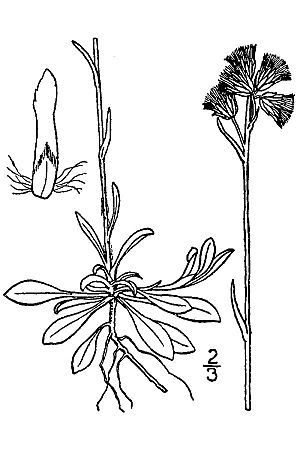Everlasting facts for kids
Quick facts for kids Everlasting |
|
|---|---|
 |
|
| Canadian pussytoes | |
| Scientific classification | |
| Genus: |
Antennaria
|
| Species: |
howellii
|
Antennaria howellii, often called everlasting or Howell's pussytoes, is a type of plant found in North America. It belongs to the sunflower family. You can find this plant in northern Alaska, many parts of Canada (including the Arctic territories), and the northern United States. It grows as far south as northern California, Colorado, and North Carolina.
This plant is an evergreen perennial plant. This means it lives for more than two years and stays green all year round. It usually grows in a flat, circular shape of leaves called a rosette at its base. These rosettes often spread out to form new plants, like a clone.
The leaves at the base are about 2–4 cm long and 6–12 mm wide. They are light green and shaped like a spoon, with a thin stem and a wider tip. The underside of these leaves is covered in soft, white, woolly hairs. The flowers appear in May. They grow on a stem that is 15–35 cm tall and has smaller, thinner leaves. You can often see Antennaria howellii growing under pine trees.
Contents
Different Types of Howell's Pussytoes
There are several different types, or subspecies, of Antennaria howellii:
- Antennaria howellii subsp. howellii – Found in the western and north-central US, and western and central Canada (including Yukon).
- Antennaria howellii subsp. canadensis – Grows in the northeastern US, and eastern and central Canada (including Labrador).
- Antennaria howellii subsp. neodioica – Found across Canada and the northern US.
- Antennaria howellii subsp. petaloidea – Also found in Canada and the northern US.
Who Was Thomas J. Howell?
The plant is named after an American botanist named Thomas J. Howell. He was the first person to collect samples of this plant in 1887.
Conservation Status
In the United States, one of the subspecies, petaloidea, is considered a special concern. This means it is a bit rare and might have disappeared from some areas, like Connecticut.
Traditional Uses by Native Americans
Some Native American groups have traditionally used this plant for medicine.
- The Nuxalk Nation would make a special drink from the leaves to help with body pain, but not pain in the arms or legs.
- The Ojibwe people would make a tea from the neodioica subspecies. They used it after childbirth to help with healing.

